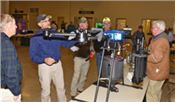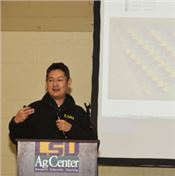|
New Technology Offers Farmers Benefits
ALEXANDRIA, LA.
Farmers can benefit from using emerging technology on their farms by reducing expenses and increasing crop yields, LSU AgCenter experts advised at a digital agriculture conference held on Jan. 23.
Bill Richardson, LSU vice president for agriculture, said the LSU College of Agriculture is developing curricula for ag technology majors. “We think the demand is only going to increase,” he said.
AgCenter engineer Randy Price said eight new high-tech weather stations have been installed at LSU AgCenter facilities across the state to provide data on weather conditions. The information can be accessed online at https://app.lsuagcenter.com/Weather/Latest.
The Federal Aviation Administration is proposing a series of new rules that would allow for tracking and identifying all drones, both recreational and commercial, with a transmitter and radio identification system, he said.
Price said he is working on a sugarcane yield monitor to complement monitors already used in the industry. The monitors are more difficult to use on sugarcane in central Louisiana because of the more varied harvest conditions, and more frequent calibration is needed to compensate for green cane in the early season.
AgCenter precision agriculture specialist Luciano Shiratsuchi will be conducting more on-farm studies this year using a variety of equipment, including drones with scanning devices, along with satellite data and telemetry.
Graduate students studying with Shiratsuchi worked with the M.A. Patout and Sons sugar company this year to predict cane yields by using satellite imagery and yield data. “We are very happy with the preliminary results," he said.
Dennis Burns, AgCenter agent in Tensas Parish, talked about his irrigation study. Furrow irrigation costs about $11 an acre, he said, so the expense justifies a thorough analysis to make the system more efficient.
A yield map can show an area that didn’t drain well. A map of one field that yielded two bales of cotton per acre had a low-yielding area that didn’t drain well. “When I showed the farmer this, he had a dirt bucket out there in 30 minutes to fix it,” Burns said.
A computer program is available to help farmers determine hole spacing for poly pipe outlets, and soil moisture sensors can be used to determine irrigation needs. Burns prefers four sensors placed 6, 12, 18 and 24 inches deep.
University of Georgia precision ag and irrigation specialist Wesley Porter said yield monitors are critical for a high-tech approach to agriculture.
A planter should be fine-tuned before seeding starts, he said.
Three Louisiana farmers related their experiences with using digital agriculture.
Ryan Kirby, who grows cotton, soybeans, corn and rice on his Caddo Parish farm, said he started using a yield monitor in 2006, and he began using liquid fertilizer applications the next year.
Kirby said Ag Leader software is key to his operation. “It’s that software that really allows me to see what’s going on in the field,” he said.
Porter said the amount of data generated by high-tech devices can be overwhelming.
“All the stuff is great, but you need to be able to use it,” he said.
Ray Schexnayder, who grows corn, soybeans and oats with two brothers in Pointe Coupee Parish, said their 12-row planter is well adjusted to obtain the best results. “A uniform stand is where your corn crop is made,” he said.
Schexnayder uses a drone to check field drainage and to find hog damage. He also wants to use Normalized Difference Vegetation Index equipment. The NDVI technology can be used to gauge crop health and to detect stress earlier than symptoms can be seen visually.
Assumption Parish sugarcane farmer Keith Dugas said he has worked with AgCenter agronomist Brenda Tubaña, who uses a Greenseeker device that incorporate NDVI technology to determine proper nitrogen levels.
Dugas said Burns and AgCenter agent R.L. Frazier installed a Greenseeker on his fertilizer spreader, and fields were grid-sampled. In some areas, the Greenseeker recommended 45 units of nitrogen, but he had been using a blanket application of 100 to 120 units, Dugas said. He admitted having doubts, but the lower amount showed no yield reductions.
Dugas conducted a test with starter fertilizer applied before planting, and the yield monitor showed an advantage. “It was 4 to 4.5 tons better where I put that starter fertilizer,” he said.
Dugas also said the American Sugar Cane League has been using a drone to scan his field to make yield predictions. “It showed some promise,” he said. ∆

LSU AgCenter engineer Randy Price, far right, answers questions about drones during a digital agriculture conference held by the LSU AgCenter on Jan. 23, 2020.
Photo by Bruce Schultz/LSU AgCenter

LSU AgCenter precision agriculture specialist Luciano Shiratsuchi talks about the use of several aspects of technology, including telemetry and
satellite data that can be applied to farmers’ crops, during an AgCenter digital agriculture conference on Jan. 23, 2020.
|
|